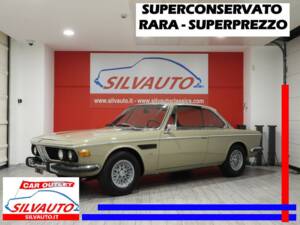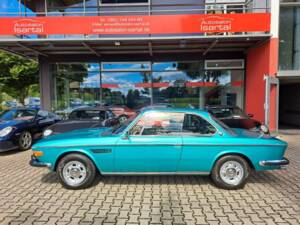BMW 2800 classic cars for sale
The BMW 2800 represents a pivotal chapter in BMW's luxury and sporting heritage, offered as both a dynamically tuned sedan (E3) and an elegant coupé (E9). Its hallmark is the M30 straight-six engine, renowned for smooth performance and characteristic BMW flair. Discover the enduring appeal of this uniquely engineered model.
Search results

1970 | BMW 2800 CS
BMW 2800 CS (E9) (1970) SUPERCONSERVATO – RARA – SUPERPREZZO

1970 | BMW 2800 CS
BMW Sonstige
History of the BMW 2800
BMW launched the 2800 series in autumn 1968, stepping back into the luxury segment with confidence after years of financial instability in the late 1950s. The E3 sedan and E9 coupé, both powered by the new M30 straight-six engine, were aimed squarely at Mercedes-Benz and other premium competitors. Crafted under the guidance of Wilhelm Hofmeister, with Giovanni Michelotti’s design influence apparent, the 2800 introduced stylistic and mechanical refinements that would shape future BMW models. Hallmarks included the round twin headlamps and a lively but comfortable chassis. By 1977, after approximately 190,000 units, the 2800 was succeeded by the BMW 7 Series (E23).
Model Series Evolution
The E3 sedan debuted as the replacement for the BMW 3200 S and was distinguished by being the first to use BMW's 'E' code. Coupé fans received the E9 2800 CS from December 1968, a model produced by Karmann and built until April 1971. The BMW 2800 range evolved into bigger-engined variants such as the 3.0 S, 3.0 Si, and 3.3, as well as long-wheelbase L versions. After the 2800 CS, the range continued with the 3.0 CS, CSi, and the renowned 3.0 CSL, with the 2800 models serving as direct predecessors for these later icons. The line’s end in 1977 made way for the next generation, but the foundational engineering and aesthetics left a lasting imprint.
Highlights and Notable Features
Distinctive to the 2800 series is the M30 engine—BMW’s first in a new generation of straight-six motors, famed for its longevity and smooth output. The E9 coupé, with around 9,400 examples, featured a hand-finished body by Karmann. Its wooden dashboard, classic round gauges, and availability of accessories like Blaupunkt radios, leather upholstery, and electric windows set a new comfort standard for the era. Original metallic paints and BBS or Alpina wheels enhance both style and value.
Technical Data
Special Editions and Noteworthy Models
Among the 2800 series, the E9 based BMW 2800 CS foreshadowed the 3.0 CSL (“Batmobile”)—a homologation special built for racing with lightweight aluminium panels, which went on to achieve motorsport glory in the European Touring Car Championships. While the standard 2800 CS was not as extreme, many of its attributes—chassis, styling, basic platform—were passed on to these iconic CSL racers.
Engine, Performance, Transmission and Handling
The 2800’s fuelled passion among drivers with its free-revving 2.8-litre straight-six (Vergasermotor) delivering 170 hp and propelling the coupé to over 200 km/h. Suspension was tuned for a sporting but balanced ride; four-wheel disc brakes and independently suspended axles marked a leap over rivals. The E9 coupé was actually lighter than some smaller BMW saloons, helping its surprisingly responsive road manners. Transmission options included a crisp 4-speed manual or smooth-shifting automatic. High-speed touring and brisk B-road cornering were both strengths of this chassis. - BMW 2800 CS (E9): 2.8-litre, 170 hp, Getrag 4-speed or automatic, 205 km/h top speed. ~9,400 units.
- BMW 2800 (E3): Sedan variant, same engine/gearbox options, recognised for substantial interior space and understated luxury.
Interior, Comfort, Exterior and Design
The BMW 2800 stands out for its harmonious proportions—frame and body lines shaped masterfully by Hofmeister and Michelotti. Notable exterior details include the signature twin round headlights and distinctive metallic colour finishes such as Polaris Silver or Baikal Blue. Coupés received fine Karmann craftsmanship, highlighted by extended use of real wood on dashboards, chrome-trimmed dials, and optional luxury features like leather or velour upholstery, genuine BMW toolkits, original Blaupunkt radio, and electric sunroof. Particular seats with lower bases in early E9s improve visibility while high-quality BBS/Alpina wheels and optional fog lamps enhance presence and functionality.
Other Features and Details
Originality is highly prized; matching numbers for engine and chassis, authentic toolkits, and documentation are significant for the market. Official cabriolet conversions are extremely rare, almost non-existent for this series. Factory accessories ranged from headrests and wood steering wheels to power antennas with anti-theft locks, reflecting the advanced features for the period. Due to known body rust issues, many cars have undergone extensive restoration and conservation.
Summary
The BMW 2800 (E3/E9) range offers a uniquely Bavarian blend of technical innovation, luxury design, and engaging performance. Coupés hold particular sway in the classic market, their combination of Karmann build quality, robust six-cylinder engines, and detailed appointments continuing to capture the attention of collectors and driving enthusiasts. Meticulously engineered and thoughtfully appointed, the BMW 2800 remains a prime example of 1970s German automotive ambition.

